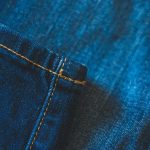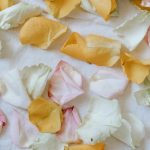I usually advise against washing organza before sewing. It's a delicate fabric and washing can actually ruin its crisp, sheen texture. Washing organza can lead to fraying, distortion, and even color bleeding. If you're worried about shrinkage, however, you might just test a small piece to see how it reacts. Overall, it's safer to handle organza with care, avoiding water unless you're dealing with pre-tested, colorfast material. If you handle it right, organza can add a stunning, elegant touch to your projects. There's more to consider when working with such a sensitive fabric, so keep exploring your options!
Table of Contents
Key Takeaways
- Washing organza before sewing can alter its crisp texture and sheen, potentially affecting the final appearance.
- Pre-washing organza helps test for colorfastness, preventing unwanted dye transfer on finished projects.
- Washing organza may cause fraying and misshaping, which can complicate the sewing process.
- If organza is not pre-washed, always ensure it is colorfast to avoid bleeding during future washes.
- Consider alternatives like spot cleaning or steaming to maintain organza's integrity while removing impurities before sewing.
Understanding Organza Fabric
Organza is a lightweight, sheer fabric that's both delicate and crisp, often used in formal wear and decorations. It's woven from silk, polyester, or a blend, which affects its feel and the way it behaves. I've found that understanding the specific type of organza I'm working with is crucial to handling it correctly.
Silk organza is the most traditional type and it's prized for its strength and natural sheen. However, it can be the most expensive. On the other hand, polyester organza is more affordable and resistant to wrinkles. Blended organza tries to offer the best of both worlds, balancing sheen, cost, and resilience.
Each type has a different character. Silk organza, for instance, tends to have a softer drape and a subtle glow, making it perfect for bridal wear. Polyester versions are often stiffer, making them ideal for structured designs like puff sleeves or stand-out decorations.
Knowing these differences helps me choose the right organza for my project. It's not just about the look; it's about how the fabric will handle during sewing and how it will perform in the finished piece. So, I always take the time to really get to know my organza.
Reasons to Pre-Wash Fabrics
Before I start cutting and sewing, I always make sure to wash my organza fabric first.
It's crucial because it helps prevent the fabric from shrinking later on, which can really mess up your final project.
Washing also ensures that the fabric's colors won't bleed and ruin your garment after it's made.
Prevents Shrinkage Issues
Pre-washing fabrics can save you from the headache of dealing with shrinkage after your project is complete. I've learned the hard way that most fabrics tend to shrink when they first meet water.
If you skip pre-washing, your beautifully tailored garment might end up too small after its first wash. Imagine spending hours on a project, only to have it not fit right—frustrating, right?
Ensures Color Fastness
Another key reason I always pre-wash fabrics is to test for color fastness and prevent any unwanted dye transfer on finished projects. Imagine spending hours on a beautiful organza dress, only to have it ruin another garment during its first wash because the dye wasn't set! That's why I make it a point to tackle this issue right from the start.
Potential Risks of Washing Organza
Washing organza can be risky, as it might shrink or lose its crisp texture. I've learned the hard way that while pre-washing fabrics is often a go-to move for sewers, organza can be a bit of a diva. Here's what might go wrong if you decide to wash it:
- Color Bleeding: Some organza fabrics, especially those that aren't colorfast, might bleed in the wash. You don't want that beautiful, vibrant color running all over the place!
- Distortion: Organza is delicate. Tossing it in a machine or even hand-washing can stretch or misshape it, which is a nightmare for precise patterns.
- Fraying Edges: This fabric frays easily when cut, and washing can exacerbate this. Fraying edges could make your sewing project look messy or unfinished.
- Water Marks: Water spots or marks can appear if organza isn't dried properly. These are notoriously difficult to remove and can ruin the overall appearance of your final piece.
In short, think twice before throwing your organza into the wash. Handling it carefully can save you a lot of grief and preserve the fabric's beauty and integrity for your sewing projects.
How Pre-Washing Affects Texture
Beyond the risks previously mentioned, pre-washing organza can also significantly alter its texture, making it less ideal for certain sewing projects. From my experience, here's what happens: organza is known for its crispness and smooth, sleek surface. When you throw it into the wash, you risk softening its unique stiffness. This mightn't sound like a big deal at first, but it truly changes the game if you're aiming for a structured look in your final piece.
What's more, pre-washing can introduce an unwanted crinkle effect. You know, that slightly puckered texture that might work for some fabrics but generally isn't what you want when you've chosen organza for its original sleek elegance. It's like expecting a smooth painting surface and finding it subtly textured; it changes the paint's application and the final look.
I've also noticed that the sheen can diminish. Fresh, unwashed organza has a subtle shimmer that catches the light beautifully. Wash it, and you might find that shimmer dulled, as if the fabric has lost some of its vitality. This isn't just about aesthetics; it affects the fabric's behavior under lights, crucial for garments meant to dazzle visually.
Techniques for Washing Organza
Despite the challenges, if you must wash organza, there are safe techniques to minimize damage. I've found that gentle handling and the right approach can keep your fabric looking its best. Let's break down these steps:
- Use Cold Water: Always opt for cold water to prevent the fabric from shrinking or losing its sheen. Hot water is a big no-no as it can weaken the fibers.
- Hand Wash Only: Machine washing can be too harsh for delicate organza. I always hand wash with a mild detergent, gently swishing the fabric in the water without twisting or wringing it.
- Dilute Detergent: Too much soap can leave residue and stiffen the fabric. I make sure to dilute the detergent in the water thoroughly before submerging the organza.
- Avoid Harsh Chemicals: Steer clear of bleach or fabric softeners. These can break down the fibers or coat them, respectively, which alters the texture and appearance.
Drying Organza Post-Wash
After washing, I lay out the organza flat on a towel to air dry, avoiding direct sunlight to prevent fading. This method ensures that the fabric doesn't lose its delicate texture or vibrant color. I make sure to smooth out any wrinkles gently with my hands, as ironing organza directly can be tricky and risky.
When drying organza, it's crucial to be patient. The fabric needs its own sweet time to dry completely, and rushing this process with a dryer or direct heat can lead to shrinkage or damage. Here's a quick guide I put together to help visualize the do's and don'ts of drying organza:
| Step | Do's | Don'ts |
|---|---|---|
| Laying | Lay flat on a clean, dry towel | Hang or drape over edges |
| Location | Choose a shaded, well-ventilated area | Expose to direct sunlight |
| Post-Drying | Check if completely dry before storing | Fold or store damp |
Testing Colorfastness
Before sewing your organza project, it's essential to check if the fabric's dye is colorfast to avoid any unwanted surprises later on. You don't want the colors bleeding onto other fabrics or losing their vibrancy after you've put in all that hard work.
Here's how I test for colorfastness in a simple and straightforward manner:
- Damp Cloth Method: I take a white cloth, dampen it slightly, and then press it against the organza. If any dye transfers onto the white cloth, it's a no-go.
- Hot Water Test: I soak a small piece of the fabric in hot water and leave it for a few minutes. After removing it, I check the water's color and the fabric's appearance to see if there's any color bleeding.
- Dry Rub Test: I rub the fabric vigorously with my fingers or a dry cloth. This helps me see if the fabric sheds color just from friction.
- Sunlight Exposure: I leave a small piece of the fabric in direct sunlight for a few hours to see if the color fades unusually quickly.
These tests help ensure that the organza I use won't give me any nasty surprises once I start sewing or after the final product is used.
Preparing Organza for Sewing
Once you've confirmed your organza is colorfast, it's time to prep it for sewing. First, you'll want to smooth out any wrinkles or creases that could mess up your cuts. I usually go for a low-heat iron with a pressing cloth between the iron and the fabric. This avoids any direct heat that can damage the organza. Make sure your ironing board is clean too, you don't want any dirt transferring onto your fabric.
Next up, let's talk cutting. Organza can be a bit tricky because it's so slippery. I always lay my fabric flat on a large table and use pattern weights to keep everything in place. This prevents the organza from shifting around when I'm cutting. Sharp scissors are a must! Dull blades can snag the delicate threads and cause fraying.
Alternatives to Washing
If you're hesitant to wash organza due to its delicate nature, consider some effective alternatives. Sometimes, skipping the wash can actually be a smarter choice, especially if you're worried about fraying or distorting the fabric. Let's dive into some handy methods that'll keep your organza in top shape without throwing it into the wash.
Here are a few tricks I use:
- Spot Cleaning: Gently dab at stains with a mild detergent solution using a soft cloth. This targets only the dirty areas without risking the whole fabric.
- Steaming: To refresh the fabric and remove wrinkles, steam can be a safer alternative. Just be sure to keep the steamer at a reasonable distance to avoid water spots.
- Air Fluffing: Hang your organza in a well-ventilated area or use a dryer's air-fluff setting (no heat!) to remove dust and odors. It's a gentle way to perk up the fabric.
- Cold Air Press: If you have a pressing concern, use a press cloth and iron on a cold setting. This smooths out wrinkles without applying heat directly to the organza.
These methods ensure that I maintain the integrity of the organza while preparing it for my sewing projects.
Best Practices in Sewing Organza
To get the best results when sewing organza, always start with sharp needles and fine thread. It's crucial because organza is so delicate and can snag easily. I've found that using a finer thread helps keep the stitches neat and almost invisible. Also, don't rush your sewing. Taking your time can really make a difference in the final look of your project.
Here's a quick guide that I often refer to when working with organza:
| Tip | Why It's Important | What I Use |
|---|---|---|
| Sharp needles | Prevents snagging | Microtex 70/10 |
| Fine thread | Invisible seams | Polyester or silk |
| Gentle handling | Reduces distortion | Careful pinning |
| French seams | Conceals raw edges | For sheer elegance |
| Low heat iron | Prevents melting | Press cloth protection |
Frequently Asked Questions
Can Ironing Replace Pre-Washing for Organza Fabric?
I wouldn't rely on ironing as a substitute for pre-washing organza. Ironing can't remove chemicals or stabilize the fabric like washing can, so it's best to stick with washing before sewing.
How Does Climate Affect Organza During Storage?
In humid climates, organza can absorb moisture, leading to mildew or odor issues. I make sure it's stored in a dry, cool place to maintain its quality and prevent any damage.
What Are Eco-Friendly Alternatives for Washing Organza?
I've found that using diluted vinegar or baking soda solutions can be eco-friendly ways to wash organza. They're gentle on the fabric and better for the environment than conventional detergents.
Can Starch Be Used on Organza Before Sewing?
I've found that using starch on organza before sewing can help stabilize the fabric, making it easier to handle. Just apply lightly and evenly to avoid stiffness and ensure smooth sewing.
Are There Specific Thread Types Recommended for Sewing Organza?
Ah, the quest for the perfect stitch! I've found that fine, smooth threads like silk or polyester work best with organza. They glide through without snagging, ensuring a clean, professional finish.
- Denim Fabric Manufacturers in Bangladesh: A Complete 2024 List - June 20, 2025
- The Ultimate Guide to Fabric Manufacturers in Bangladesh - June 20, 2025
- Fabric Face-Off: Burnout vs. Embroidered Textiles - June 20, 2025







